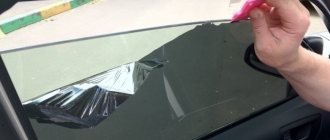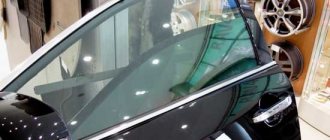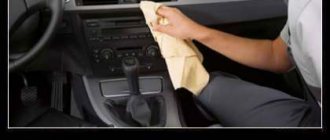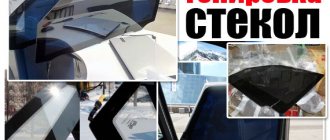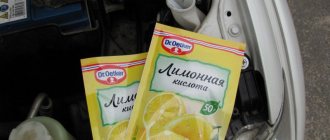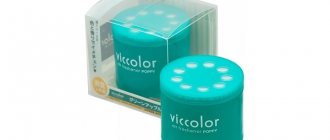Share on social media networks:
Quite often, car owners need to remove window tint. And even the problem is not how to tear off the special film, but how to remove the tinting adhesive from the glass, since if it is installed incorrectly, unpleasant traces of the adhesive remain on the glass. In general, removing film from glass is a simple process; you only need to know a few tricks, but the service station will charge you a considerable amount for this work. That's why we decided to introduce you to the methods of removing the film and tell you how to remove tinting glue from glass.
Characteristics of tint film
The tinting material is made from a thin layer of polyester. There are several such layers on the film. And its ability to transmit light depends on their number.
When installing the material, the film is glued to the glass using the adhesive composition on it. The gluing process is quite simple:
- the surface is degreased;
- then a soap solution is applied and a film cut to size is glued on.
The glue hardens on the glass and the film adheres to the surface.
A little about adhesives
Depending on what kind of glue was used in the manufacture of the film, the method of its removal also depends. The adhesive composition is a high-level adhesive coating.
Important! Adhesives are chemicals that hold different materials together through surface adhesion.
Adhesives include:
- glue;
- resin;
- bitumen;
- liquid polymers;
- some types of clear varnishes.
Important! The stronger the composition applied to the material, the more durable and stronger the film “sits” on the glass. Which means it’s harder to tear it off. Although, some Chinese-made analogues fall off on their own, which indicates poor quality of the adhesive.
Adhesive compositions also differ according to the principle of application. Each of them begins to work only under certain conditions. For example:
- DPS (Detackified Pressure Sensitive) is activated after applying water. First, craftsmen wet the surface and then apply a film.
- CD - begins to activate with increasing temperature. To glue such material, it must first be heated.
- CDF - glued using a special solution from the manufacturer.
- PS (Pressure Sensitive) - starts working under pressure. The film must be pressed onto the glass for it to stick. At present, such a composition is practically not used.
- PS/DT - activated by water. However, there should not be a lot of liquid. Be sure to remove excess water with a scraper to prevent “bubbles” from forming on the film.
Important! Due to the different adhesive composition and its quality, as well as the service life of the film, it is impossible to give general advice on how to remove tinting adhesive from glass. The longer the film was on the surface, the more capricious it will be when removed.
Make your own cleaning solution
Gather the necessary ingredients. Most ammonia-free cleaners use mild soap, such as baby soap, as well as water and disinfectants such as alcohol. These are the three main components. Distilled water should also be used when mixing ingredients. It does not contain impurities such as calcium and limescale, which can leave spots, streaks or streaks on the glass. These products can most likely be purchased at a home improvement store or in the supply section of your local grocery store. You will need:
- baby soap;
- distilled water;
- isopropyl alcohol (91% is preferred, but a lower percentage will do);
- container with sprayer.
Take an empty spray bottle and rinse thoroughly. Then add 2 tablespoons (29.6 ml) alcohol and a few drops of baby soap. Fill the bottle with distilled water, screw on the cap and mix the contents thoroughly.
The alcohol contained in the glass cleaning liquid will help the detergent evaporate quickly, which will prevent streaks. Alcohol also helps dissolve fats and oils.
These ingredients have a relatively long shelf life and can be used to make large quantities of cleaning product. In addition, this will allow you to save a significant amount of money. In this case, the result will be no worse than after using a product purchased in a store.
Apply more detergent to dirty areas of your car windows. Wipe clean glass with a semi-dry cloth.
Film removal methods
Tinting is applied to the inside of the glass. Removing it will require a little patience and accuracy. Successful removal of adhesive composition is 80% dependent on proper removal of the film.
There are several ways to remove tinting:
- Cutting. If you find yourself in a problematic situation and you are facing a fine from a traffic police officer, then try to remove the film in one motion: pry up the edge of the canvas, grasp it with both hands, and sharply pull it down. The adhesive composition, of course, will remain, but there will be much less of it.
- Smooth. When the film is smoothly removed, a minimum of glue will remain on the glass. Proceed as follows:
- Warm up the glass (up to 40-60 degrees) using an industrial (household hair dryer). The adhesive mass will become soft and come off along with the film.
- Pry off the film with a blade or knife.
- Pull the film off the surface with smooth movements, constantly heating the glass.
- Using a soap solution. Pry off the film with a knife and add soapy water to the separation area. Slowly remove the film from the glass, adding soap solution to the separation points.
Helpful Tips:
- Don't overheat the hairdryer to avoid damaging the plastic finish and melting the film. Make sure that the hairdryer heats up, otherwise the glass may crack under the influence of high temperatures.
- If you are removing film from the side windows, then for ease of removal, lower the glass to the middle. This will make it easier to get to the edge of the film.
- If you are removing tinting from the rear window, be very careful not to damage the heating filaments.
- Remaining sticky substances must be removed, as they interfere with visibility and can collect dirt and dust. In addition, glue residues can damage the window regulators.
Next, we will tell you how to remove tinting adhesive from glass.
Clean your windows last
Windows are one of the most visible parts of a car. Accidental splashing or spreading of dirt while cleaning other parts of the machine may result in additional contamination of the glass. Before you begin cleaning your windows, thoroughly clean the exterior and interior of your vehicle.
While cleaning other parts of the car, pay attention to the condition of the windows and tinting. Before starting cleaning, it is recommended to apply a special intensive product to remove thick dirt on the most contaminated areas. This will make further work much easier.
If you intend to clean the inside of the windows, do not use cleaners intended for other parts of the car. Window tint is most likely attached on the inside, so if you use an ammonia-based cleaner (which is completely safe on the outside of glass), it can damage the tint layer and change the tint.
How to remove tinting glue from glass?
The main rule for those who do not know how to remove tinting glue from glass is to avoid experiments and choose only proven methods. You can use available tools for work:
- Soap solution.
- Mild steel scraper (blade from a stationery knife).
- Acetone, kerosene, gasoline, white spirit, liquid for washing carburetors and injectors.
Special chemical agents have proven themselves to be excellent in the fight against glue residues:
- Biosolvent “Cytosol”.
- Universal household cleaner “Profoam 2000”.
- Various glue cleaners (aerosols “ZM 08184”, “ZM 08984”).
We will tell you below how to use the above tools.
Method number 1. Mechanical
Usually a special scraper or a special spatula is used to scrape off the adhesive. If they are not there, then use a blade from a stationery knife.
Proceed as follows:
- Fill a spray bottle with soapy water. For effectiveness, add a few drops of ammonia to the solution. Instead of soap solution, you can use glass washing liquid containing ethyl alcohol.
- Heat the dried glue with a hairdryer.
- Spray soapy water onto the glass.
- Cut off the glue layer using the prepared tool. Hold the blade at an angle of 30-40 degrees to the surface and scrape off the sticky layer without much effort to avoid scratching the glass.
- After cleaning the surface, degrease it with alcohol or solvent.
Method number 2. Laundry soap
To make a mixture for dissolving the adhesive, use one of the following available tools:
- Laundry soap. It needs to be grated or cut into slices and dissolved in water.
- Dishwashing liquid. Prepare foam from the product.
Use the soap solution as follows:
- Apply soap solution to the surface.
- Wait for it to dry completely.
- Apply the soap solution to the glass again.
- Carefully remove the adhesive with the back of a scouring sponge.
- Wipe the surface dry with a rag.
Method number 3. Petroleum-containing substances:
- Wet a cloth with one of the solvents - gasoline, kerosene, acetone, white spirit.
- Wipe the surface thoroughly with the product.
- Wait a couple of minutes. The glue will become soft and can be removed even with a plastic card.
- Remove any remaining glue.
Important! The disadvantage of this method is the flammability and specific smell. Always remember about the toxicity of petroleum-containing products and do not forget about safety measures. Handle these products carefully to avoid contaminating the interior trim and seats.
Method number 4. Special liquid sprays for removing tint
Many stores sell household chemical adhesive removers. Use the products as follows:
- Apply a special product to the surface.
- Wait a couple of minutes for the glue to dissolve.
- Remove any remaining adhesive with a soft spatula.
- Wipe the glass dry.
Important! Disadvantages of this method:
- Toxicity.
- High price of the product.
Method No. 5. Rust converter
Buy “Star Wax” rust converter at any hardware store and apply it to the surface. After 5-10 minutes, remove the product along with the glue with a rag.
Method number 6. “Super Moment Anti-Glue” product
Not long ago, a product appeared on sale that can remove adhesive stains of various compositions. The product has a gel consistency and is suitable for use on vertical surfaces.
Use a gel-like composition, just like a solvent.
Method No. 7. Biosolvent “Citosol”
The solvent quickly and effectively copes with the bitumen and vinyl components of the adhesive composition. The product is non-toxic and has the widest range of applications.
Method No. 8. Household water repellents
The well-known anti-corrosion spray WD-40 or car “Anti-rain” will help get rid of the adhesive composition. Use the product in the same way as solvent.
Method number 9. Universal household cleaner “Profoam 2000”
The cleaner is designed to remove various stickers and tape residues from all surfaces. You can purchase the product at any automotive store.
Method No. 10. Liquid for cleaning the body from insects
A liquid for cleaning headlights and bodywork from silicone deposits and insects will help solve the problem. There are a lot of such products in the automotive supply store, so choose the one that is more effective, that is, stronger.
Method No. 11. Glue cleaners “ZM 08184” or “ZM 08984”
Various glue cleaners will help clean the surface of the adhesive. Aerosol “ZM 08184” is also called “orange” due to its smell.
Important! The products are designed to wash off not only glue, but also mastic, silicone, and oils. The product does not damage the surface and is quite effective.
Method No. 12. Unusual means at hand
Many car enthusiasts use drinks such as Coca-Cola and Pepsi to remove glue. Wipe the glass with a sponge soaked in the drink.
Important! In any case, always start by removing the adhesive in the easiest way possible. Depending on the effect, you will understand what the foundation reacts to. For example, if the solvent did not work to remove the remaining adhesive mass, then try a product with a fundamentally different composition, and vice versa.
Preparing tinted glass for washing
Before cleaning, park your car in the shade. Parking in the sun can cause cleaning products to dry out quickly, making it difficult to spread the cleaner across the glass surface, as well as to lather, rinse and dry. This may result in stains or incomplete cleaning. Many car wash professionals recommend parking in a garage, but if that's not an option for you, look for a suitable tree with lush foliage or a ledge to park your car under.
Be aware that some trees, such as pine trees, produce a sticky resin that, if touched, can damage the finish of your vehicle. Check the trees in front of the parking lot. If you notice that the ground under a tree is discolored, this may be an indication that you should not park your car there.
My daughter-in-law turned my old chest of drawers into a dollhouse: she didn’t recognize the furniture right away
Forbes “crossed out” Kylie Jenner from the list of billionaires: businesswoman’s reaction
How theaters will work after coronavirus: the experience of the Berlin Theater
